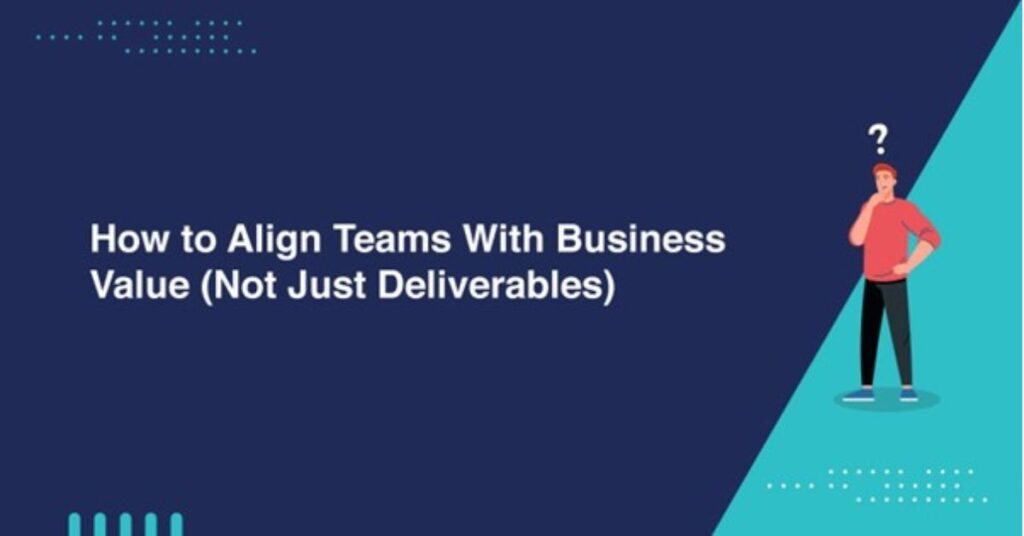In many organizations, teams are appraised for their “great finish of tasks on time “. They meet their deadlines, complete the features in time, and complete each task off the to-do list. But the challenge is: “We delivered everything as we promised, if so, why aren’t our sales increasing? Why don’t our customers feel happier?”
This is the usual trap of focusing on deliverables instead of business value. It’s like when a chef is perfectly cooking the recipe; however, no one in the dining room is enjoying the food.
So, how can we go from “building things” to “building things that matter”? Let’s explore this in this blog.
Understand the Difference between Business Value & Deliverables:
It’s essential to get to know the difference between deliverables and business value.
- Deliverable is a thing. It’s the feature, the report, the project milestone. It’s the output.
- In Focus: “Did we build the thing correctly?”
- Success is: The task is accomplished.
- Business Value is the impact. It’s the positive effect that the “thing” creates for the company or its customers.
- The focus: “Did building the thing create the result we wanted?”
- Success is: The thing that has made a difference (e.g., the increase in revenue, better customer satisfaction).
For example, making a “one-click checkout” button is a deliverable. The increase in online sales of 15% due to that button has a business value.
Moving your team’s focus away from the first to the second is an important game-changer. Here’s how you can do it.
5 Steps to Align Your Team with the Business Value:
1. Begin by asking the “Why”
Teams aren’t able to hit targets they cannot achieve. Before starting any project, it is important to communicate clearly the goals of the project.
- Don’t tell people: “We need to build a new notification system.”
- Instead, you can say: “We are losing users because they feel out of the loop. Our goal is to improve customer retention. The new notification system is one way we hope to achieve that by re-engaging them.”
If the team can understand the “why,” they come up with ideas that you never thought of and feel connected to a larger purpose.
2. Set Goals Based on Outcomes, Not Outputs
Stop defining success in terms of “Project Completed.” Start defining it as “Problem Solved.”
One way to accomplish this is by using an OKRs framework (Objectives and Key Results).
- The Old Objective (Output): “Launch the new search feature by Q3.”
- New Goal (Outcome):
- Goal: Make it easy for users to locate the information they require.
- Key Results 1: Reduce the number of failed searches by 40%.
- Key Results 2: Increase the number of page clicks on search results by 20%.
Look at the difference? The first goal is completed when the feature launches. The second goal is to keep focus on actual impact.
3. Keep the Customer in the Room
It’s easy to lose yourself in deadlines and code. Make sure to remind the team regularly who they are building for.
Send feedback from users, customer ticket support, as well as stories of the real-life experiences of people who use your product. When a programmer realizes that the feature they are developing can save a frustrated user 10 minutes, the work they do is more valuable. They are no longer simply coders, and instead, they are called problem solvers.
4. Make Value a Daily Habit
Incorporate business-related value into the daily routine of your team.
- When you are in Sprint Planning, don’t just write down tasks. Begin by saying, “This sprint, we are working towards our key result of improving user onboarding.”
- For User Stories, don’t write “As a user, I want to filter products.” Include the following information: “…so that I can quickly find what I need and complete my purchase.”
- In Demos: Instead of showing the building, explain the reason why it was built. Demonstrate how it moves the needle in your most important outcomes.
5. Celebrate the Right Wins
What you choose to celebrate is the way you promote. Begin to celebrate the outcomes! Did the satisfaction scores of customers rise? Did a new feature contribute to more registrations? Celebrate that! Recognize the role of your team in making that impact. This conveys a strong statement: “We care about results, not just activity.”
6. Master the Mindset with Agile Training
As a professional, you can master Scrum concepts through CSM training, which teaches you to align teams with business value, not just deliverables, by shifting focus from output to outcome, which means not only taskmasters make sure deliverables are completed, but also become facilitators who help the team focus on creating value.
The Bottom Line:
Changing from a “feature factory” to a value-driven team isn’t something that happens overnight. The process requires a conscious change in the way we work, plan, and evaluate the success of our efforts.
However, the rewards are huge. You will create a group of strategically-minded, energized thinkers who are truly committed to the success of your business. They will not just be making things work; they will be building the right things. You never ignore this competitive advantage.
Also Read: 5StarsStocks.com 3D Printing Stocks Guide for Investors

